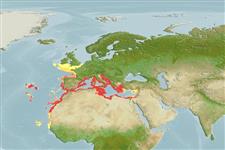Issue
Muraena augusti (Kaup, 1856) is considered as a valid species by Jiménez et al. (2007: Ref. 58348). Page to be created soon.
Environment: milieu / climate zone / depth range / distribution range
Écologie
marin récifal; profondeur 1 - 801 m (Ref. 58348), usually 100 - 300 m (Ref. 58348). Subtropical; 52°N - 13°N, 32°W - 36°E
Eastern Atlantic: south of British Isles to Senegal, including the Mediterranean, Azores, Madeira, Canary Islands, and Cape Verde.
Length at first maturity / Taille / Poids / Âge
Maturity: Lm 75.5, range 69 - ? cm
Max length : 150 cm TL mâle / non sexé; (Ref. 12382); common length : 80.0 cm TL mâle / non sexé; (Ref. 3397); poids max. publié: 6.5 kg (Ref. 58348); âge max. reporté: 38 années (Ref. 58348)
A nocturnal and territorial species (Ref. 12382), commonly lurking in holes, and writhing snakelike through crevices, under rocks or corals. Feeds on fish, crabs and squid (Ref. 12382). It seldom attacks unless provoked (Ref. 3256). A gonochoristic species (Ref. 32169). Utilized fresh and eaten broiled, boiled and baked; the skin can be used for leather (Ref. 9987).
Migrate to offshore waters to spawn (Ref. 98745).
Smith, D.G. and E.B. Böhlke, 1990. Muraenidae. p. 136-148. In J.C. Quero, J.C. Hureau, C. Karrer, A. Post and L. Saldanha (eds.) Check-list of the fishes of the eastern tropical Atlantic (CLOFETA). JNICT, Lisbon; SEI, Paris; and UNESCO, Paris. Vol. 1. (Ref. 4450)
Statut dans la liste rouge de l'IUCN (Ref. 130435)
Menace pour l'homme
Traumatogenic (Ref. 4690)
Utilisations par l'homme
Pêcheries: intérêt commercial mineur; Aquarium: Aquariums publics
Outils
Articles particuliers
Télécharger en XML
Sources Internet
Estimates based on models
Preferred temperature (Ref.
123201): 13.1 - 16.2, mean 14.4 °C (based on 181 cells).
Phylogenetic diversity index (Ref.
82804): PD
50 = 0.5010 [Uniqueness, from 0.5 = low to 2.0 = high].
Bayesian length-weight: a=0.00056 (0.00048 - 0.00066), b=3.27 (3.23 - 3.31), in cm total length, based on LWR estimates for this species (Ref.
93245).
Niveau trophique (Ref.
69278): 4.2 ±0.61 se; based on food items.
Résilience (Ref.
120179): Très faible, temps minimum de doublement de population supérieur à 14 ans (tmax=38.1; tm=7.1; K=0.078).
Fishing Vulnerability (Ref.
59153): Very high vulnerability (79 of 100).
Climate Vulnerability (Ref.
125649): Moderate to high vulnerability (53 of 100).
Nutrients (Ref.
124155): Calcium = 11.6 [5.8, 23.4] mg/100g; Iron = 0.433 [0.231, 0.841] mg/100g; Protein = 19.3 [17.0, 21.8] %; Omega3 = 0.193 [0.077, 0.603] g/100g; Selenium = 40.8 [19.0, 84.1] μg/100g; VitaminA = 42.5 [12.0, 154.1] μg/100g; Zinc = 0.452 [0.295, 0.682] mg/100g (wet weight);
